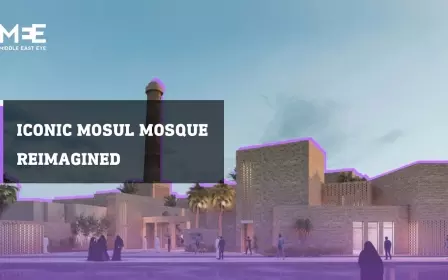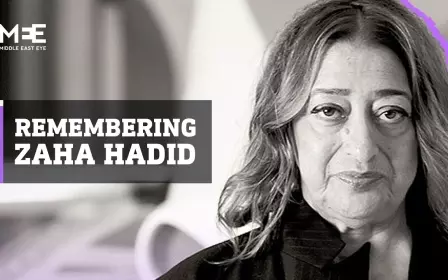In pictures: Inside Hisham's Palace, Palestine's lost Umayyad castle
Hisham’s Palace is an Umayyad castle dated to the mid-eighth century and is one of the most important archaeological sites in the occupied West Bank. It was built during the rule of the Umayyad Caliph Hisham ibn Abdul Malik (724-743 CE) in the city of Jericho and is notable for its intricate structural design and elaborate interiors, which borrows from the region's pre-Islamic Byzantine rulers. The palace, which features one of the world's largest floor mosaics, was used by the Umayyads as a resting place during the winter months. (All photos by Atef Daglas)
An earthquake hit the Jordan Valley in 749 CE and destroyed much of the palace but Palestinian officials have worked on restoring the structure to its former glories during the past two decades with help from international donors. The two-storey palace once spanned an area of around 30,000 square metres, separated into 22 different sections. Facilities included a large hammam (bath), a mosque, fountain and gated walls.
Placed directly beneath the dome of the hammam is one of the largest mosaic murals in the world, made up of stones of 21 different colours. The design of the decorative mural consists of a basket of flowers surrounded by geometric shapes, forming a rose expanding outwards.
Eyad Hamdan, the director of the Ministry of Tourism office in Jericho, told Middle East Eye that in order to create such a vast mosaic, stones were collected from around Palestine: “In order to complete one square metre of the mosaic, you would need 10,000 small stones, some of them one centimetre squared - so you can probably imagine the significance of completing an area which spans 827 metres squared. There are even some stones which are smaller than this size,” he said.
“The stones came from cities and regions from all over Palestine - the white stones were from Hebron, the yellow from Birzeit, and the black from Nabi Musa, an area near the Dead Sea. The red stones are from Jerusalem and Bethlehem."
The hammam itself, the second-largest building on the site, covers an area of around 30 square metres and is located north of the palace. The rounded arches were designed to support the structure of the building and its bricks were made from baked clay. Carved stones, statues and murals were used to decorate the hammam and the reception hall.
One of the most prominent and recognised features of the palace is the Tree of Life mural, located in the caliph’s diwan, where he would receive his guests. The mural is packed full of philosophical symbolism, reflecting the nature of life. On the right of the tree a lion devours gazelle, and on the left two gazelles graze peacefully. The images symbolise the duality of life; good and evil, war and peace. The diwan originally contained a number of statues, which have since been moved to the Palestinian Museum in Jerusalem, also known as the "Rockefeller Archealogical Museum".
Stucco carvings were widely used throughout the site, particularly to decorate walls, arches, ceilings, niches, windows and balconies. Some of the most impressive designs and carvings were found in the diwan room and the reception hall. The carvings depicted humans, animals, and plants as well as geometric designs. The reception hall and the entrance included human sculptures, which were made to near scale. Many of these statues can still be seen today at the Palestine Museum in Jerusalem.
This image shows a model structure located on the northern side of the palace. It was built in an effort to illustrate what the palace looked like before it was damaged in the earthquake.
Over the years, many efforts have been made to recover and restore parts of the palace, some of which have failed. The Palestinian Ministry of Tourism has also erected a canopy to protect the mosaics in the palace, with funding from the Japanese International Cooperation Agency (JICA). Covering an area of 2,500 square metres, the canopy also covers the reception hall and the hammam. According to Hamdan, restoration efforts have been hindered as a result of restrictions enforced by Israeli occupation authorities, which have made it hard to move equipment into the area.
"The Israeli occupation stopped many of the materials and equipment needed for the canopy which were donated by Japan. However, a lot of it was later allowed following pressure from the Japanese government," Hamdan said.
"The canopy, which is shaped like a tent, covers the mosaic floor, and protects it from extreme temperatures, humidity, and rain. It allows people to come and see it, without it being trampled on and damaged. It’s made the process for tourists visiting much more organised."
Editor's note: This article has been corrected to say that an earthquake that destroyed the palace occured in 749 CE and not 949 CE as previously stated.
This article is available in French on Middle East Eye French edition.
Middle East Eye propose une couverture et une analyse indépendantes et incomparables du Moyen-Orient, de l’Afrique du Nord et d’autres régions du monde. Pour en savoir plus sur la reprise de ce contenu et les frais qui s’appliquent, veuillez remplir ce formulaire [en anglais]. Pour en savoir plus sur MEE, cliquez ici [en anglais].




